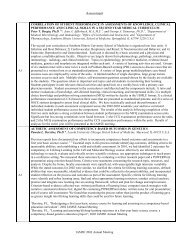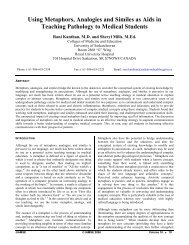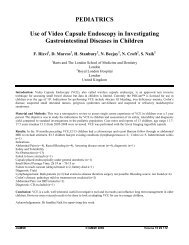Click here to view complete journal in pdf-format - IAMSE
Click here to view complete journal in pdf-format - IAMSE
Click here to view complete journal in pdf-format - IAMSE
Create successful ePaper yourself
Turn your PDF publications into a flip-book with our unique Google optimized e-Paper software.
applied <strong>to</strong> a lecture versus a small group sett<strong>in</strong>g<br />
versus team-based learn<strong>in</strong>g.<br />
Learner<br />
Teacher<br />
Table 1<br />
Gives<br />
Receives<br />
Another application of Table 1 would be <strong>to</strong> use it <strong>to</strong><br />
analyze the difference between a traditional lecture<br />
sett<strong>in</strong>g (that is not audio- or videotaped) and a<br />
lecture that is recorded and posted on a web site for<br />
later <strong>view</strong><strong>in</strong>g (i.e., podcast<strong>in</strong>g). It is well known that,<br />
while video stream<strong>in</strong>g of lectures may still provide<br />
the knowledge and context that students need, it<br />
also may lower physical attendance <strong>in</strong> the<br />
classroom. Although it is common for teachers <strong>to</strong><br />
focus on the lack of student attendance, Table 1<br />
might reveal that the fundamental problem lies <strong>in</strong><br />
the lower right-hand cell – i.e., that, under<br />
conditions <strong>in</strong> which lectures are taped and available<br />
on the Internet, teachers do not receive the<br />
attention and feedback on which they rely both for<br />
calibrat<strong>in</strong>g their teach<strong>in</strong>g <strong>to</strong> students' needs and for<br />
<strong>in</strong>ternal reward. This realization could lead <strong>to</strong> better<br />
solutions than would a narrow focus on lack of<br />
attendance.<br />
Another framework through which <strong>to</strong> <strong>view</strong> the LTR<br />
is the social theory of Max Weber, one of the<br />
founders of the modern discipl<strong>in</strong>e of sociology. 1<br />
Weber developed a theory of “ideal types,” stat<strong>in</strong>g<br />
that "An ideal type is formed by the one-sided<br />
accentuation of one or more po<strong>in</strong>ts of <strong>view</strong> and by<br />
the synthesis of a great many diffuse, discrete, more<br />
or less present and occasionally absent concrete<br />
<strong>in</strong>dividual phenomena, which are arranged<br />
accord<strong>in</strong>g <strong>to</strong> those one-sidedly emphasized<br />
<strong>view</strong>po<strong>in</strong>ts <strong>in</strong><strong>to</strong> a unified analytical construct." 3<br />
If we apply Weber’s theory <strong>to</strong> the LTR, it helps<br />
illum<strong>in</strong>ate different characteristics of “idealized”<br />
learner-teacher relationships and reveals how<br />
different types of LTRs may exist along a<br />
cont<strong>in</strong>uum. (See Table 2)<br />
In this application of Weber’s theory <strong>to</strong> the LTR,<br />
paternalistic and cooperative LTR types lie at two<br />
ends of a cont<strong>in</strong>uum. In accordance with Weber’s<br />
theory, no <strong>in</strong>dividual LTR needs <strong>to</strong> fit all of the<br />
characteristics of one type, and a given LTR may<br />
exist somew<strong>here</strong> <strong>in</strong> between the two def<strong>in</strong>ed<br />
models.<br />
For purposes of <strong>complete</strong>ness, it is worth<br />
mention<strong>in</strong>g that theoretically, another LTR “ideal<br />
type” — perhaps it would be labeled “anarchic” —<br />
may exist further <strong>to</strong> the right of the collaborative<br />
type def<strong>in</strong>ed <strong>in</strong> Table 2. This “anarchic LTR” would<br />
be one <strong>in</strong> which the student is <strong>in</strong> full command of<br />
the learn<strong>in</strong>g environment and the teacher functions<br />
strictly as a resource <strong>to</strong> be used at the student's<br />
behest.<br />
For some time now, medical education has been<br />
evolv<strong>in</strong>g from a paternalistic ideal type <strong>to</strong> a more<br />
collaborative ideal type. We can use these ideal<br />
types, as def<strong>in</strong>ed <strong>in</strong> Table 2, as a lens through which<br />
<strong>to</strong> <strong>view</strong> the problem mentioned above – that<br />
technological delivery methods for lectures might<br />
lower learner attendance, and might t<strong>here</strong>fore<br />
compromise teachers' experience <strong>in</strong> the classroom.<br />
Conception<br />
of Teacher<br />
Task of<br />
Teacher<br />
Conception<br />
of Learner<br />
Task of<br />
Learner<br />
Paternalistic …* Collaborative<br />
Expert,<br />
authority<br />
figure<br />
Provide<br />
<strong>in</strong><strong>format</strong>ion<br />
Blank slate<br />
Acquire<br />
knowledge<br />
Control Teacher … Shared<br />
Stress on<br />
student<br />
Teacher<br />
<strong>view</strong> of<br />
student<br />
Warrant<br />
student<br />
competence<br />
Relatively<br />
lower<br />
A dependent<br />
child<br />
Teacher<br />
…<br />
…<br />
…<br />
…<br />
…<br />
…<br />
…<br />
Expert, coach,<br />
guide, facilita<strong>to</strong>r<br />
Design experience<br />
<strong>to</strong> foster<br />
understand<strong>in</strong>g<br />
Primed slate (prior<br />
experience and<br />
knowledge provide<br />
context)<br />
Construction of<br />
mean<strong>in</strong>g<br />
Relatively higher<br />
An <strong>in</strong>dependent<br />
adult<br />
Faculty member<br />
who does not teach<br />
<strong>in</strong> the course/unit<br />
Table 2: Paternalistic & Collaborative Ideal Types of Learner-<br />
Teacher Relationships<br />
*The ellipsis <strong>in</strong>dicates that the “paternalistic” and<br />
“collaborative” types lie at each end of a cont<strong>in</strong>uum.<br />
In the context of a paternalistic LTR, one can<br />
imag<strong>in</strong>e the teacher simply requir<strong>in</strong>g that students<br />
be physically present at lectures. (After all, by<br />
def<strong>in</strong>ition, the focus of a paternalistic LTR is on the<br />
transmission of <strong>in</strong><strong>format</strong>ion, and podcast<strong>in</strong>g<br />
accomplishes that goal quite well. So, either the<br />
teacher could elim<strong>in</strong>ate podcast<strong>in</strong>g or require<br />
attendance.) However, a collaborative LTR fosters a<br />
broader approach <strong>to</strong> consider<strong>in</strong>g potential solutions<br />
<strong>to</strong> the “podcast<strong>in</strong>g” problem. For example, s<strong>in</strong>ce a<br />
Medical Science Educa<strong>to</strong>r © <strong>IAMSE</strong> 2012 Volume 22(4S) 265












